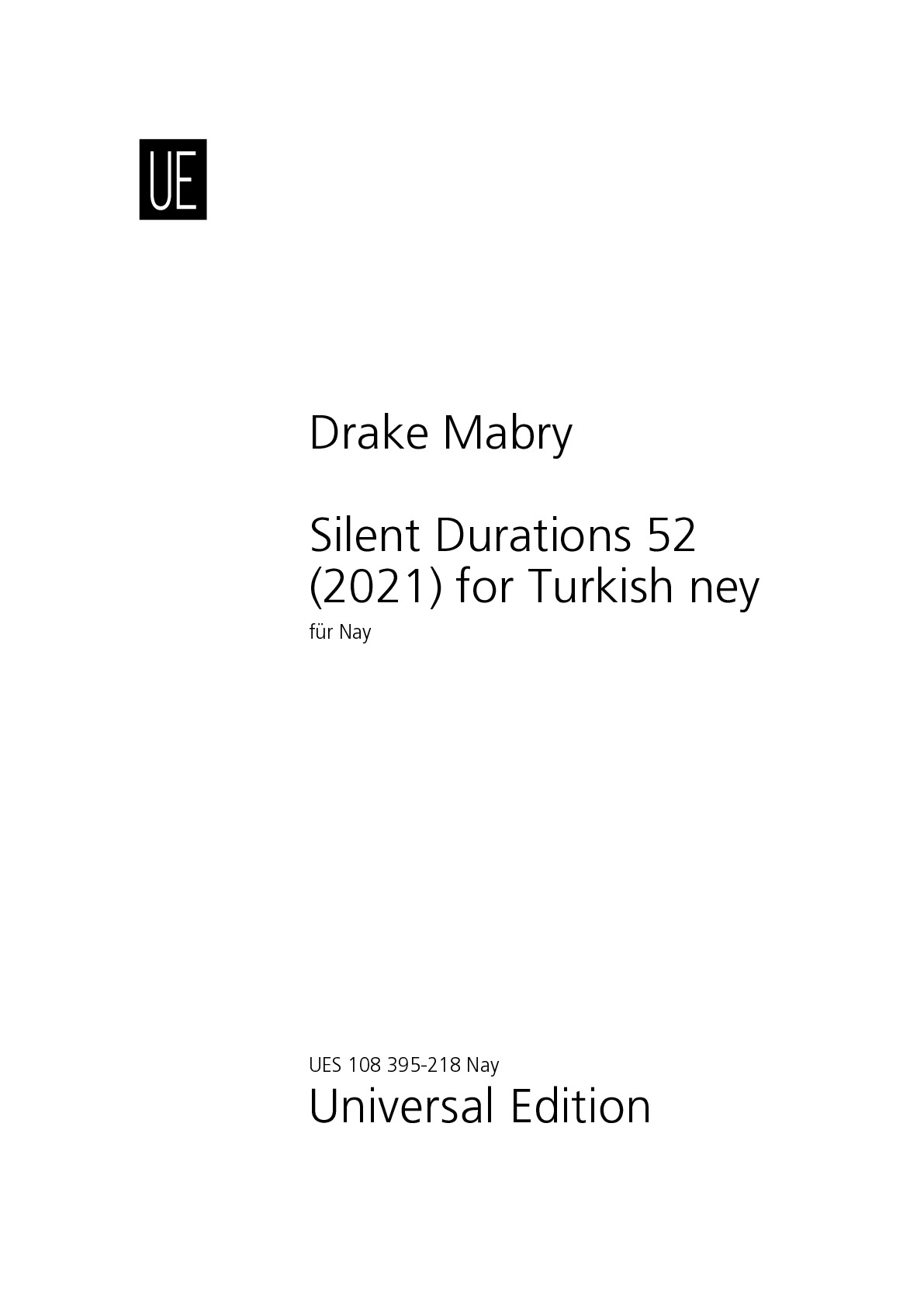.png)
Digital edition
immediately available as PDF
€7.95
Payments:
Shipping:
Drake Mabry
Silent Durations 52 for Turkish ney
UES108395-218
Type: Noten
Format: 210 x 297 mm
Pages: 8
Digital edition
immediately available as PDF
€7.95
Payments:
Shipping:
Description
Silent Durations 52 (2021) for the Turkish ney, composed and performed by Drake Mabry
The 21st Century Turkish Ney
I went to Istanbul from 2011-2013 to study the Turkish ney along with ebru art. My first ney teacher was Burcu Karada?, and later Ismail Hakki (who also makes my Bolahenk, Kiz, Mansur and Sah ney instruments). These studies were centered on the ney and its tradition based on the style and repertoire of the Sufi Ottoman period. They included the microtonal makams and the teaching method 'Mesk' in which important elements of the techniques and style are communicated by the oral tradition. My years in Istanbul were rich and intense with learning, discovery, practice, and performance, and I remain in contact with Istanbul thanks to Skype.
The Turkish ney is an oblique, end-blown flute made of bamboo (arundo donax) topped with a mouthpiece usually made from the horn of a water buffalo. It has six finger holes on the front and one on the back and is considered one of the most difficult instruments to learn and to play. The earliest examples date from over 3000 years ago, and the instrument has undergone only modest changes in design since. The music associated with this flute dates from the Ottoman empire; the ney is an important member of the small instrumental ensemble that accompanies the Sufi twirling dervish ceremonies.
Although the tradition of Turkish ney playing includes a wide diversity of sound and expression, the works in this 21st Century Turkish Ney series take the instrument into a new world of instrumental colors. During his studies of the traditional style and repertoire of the ney, Drake Mabry began to research and develop alternative perspectives of sound production. This led to new techniques such as tongue-rams, pizzicato, trumpet technique, finger pops, singing while playing, "ghost ney", and others, all with their own musical expressions. These techniques also work with slightly different results when the mouthpiece is removed and the ney is played from the other end of the instrument. The fruits of this research can be seen in over 60 contemporary music compositions written by 18 composers, a guide book for composing for the 21st Century, and a double CD album "The Wandering Ney I and II". I have recorded videos and recordings of contemporary music for the ney in various formats which can be found on the internet and at my website.
I hope the 21st Century will see the continuation of the wonderful Turkish ney tradition along with discoveries of new musical inventions for this instrument.
Drake Mabry: Silent Durations
The Silent Durations series - where sound and silence are treated as equals, each being complementary to the other as two perspectives of the same source.
Some have described my Silent Durations pieces as a zen moment in time with each silence and each sound to be heard as flourishing individual elements within a cohesive overall soundscape. Some might say they don't know what to do while waiting for the next sound event to appear. And some will just enjoy the silences linked by sounds.
All of these explanations are valid and, in my Silent Durations, I have no philosophy to demonstrate or social statement to make, but am just expressing what I want to hear through the act of composition. They are what you want them to be and my only wish is that you enjoy this listening moment regardless of the labels you might or might not want to apply to the experience. The Silent Durations Collection began in 2003 and today numbers over 60 works.
The following is the original explanation page as an aid for performing silent duration pieces:
Silent Durations - Performance notes for all instruments, 2003
In all "Silent Durations" pieces the silences are an active component of the piece and not "dead" or "empty" time. These musical silences have the same importance as the notes. Do not be tempted to shorten the duration of the silences as they are key elements in the architecture of the work.
1. Play with a beautiful sound without vibrato unless otherwise indicated.
2. In general, notes are to be attacked and released in an elegant, non-violent manner.
3. Notes which do not end with a written diminuendo should be gently stopped, leaving a feeling of suspension and continuation.
For wind instruments it will be necessary to stop the air flow with the diaphragm
rather than the tongue.
4. Performers should note the following when phrasing occurs over several silences:
a. When playing the first part of a phrase, consider where the phrase is going.
b. When playing an intermediary phrase, consider where the phrase came from,
where it is now, and where it will go.
c. And for the last part of a phrase, consider all that has happened before.
Sometimes dashed lines are used to indicate overall phrasing.
Even when there are no phrasing indications, the performer should consider the
placement of each phrase in relation to the overall evolution of the movement.
5. These are not pieces with an intentional theatrical element. The general idea is to avoid any obvious visual indication of when upcoming entrances are going to occur. Each performer will have to experiment to find the best solution for their particular performing situation.
6. Due to the lengths of the silent portions of these works, outside sounds may intervene in the piece. This does not disturb the composer. These pieces have been played in traditional concert halls as well as in less traditional performance situations such as museums and other indoor and outdoor locations.
More information
Type: Noten
Format: 210 x 297 mm
Pages: 8

